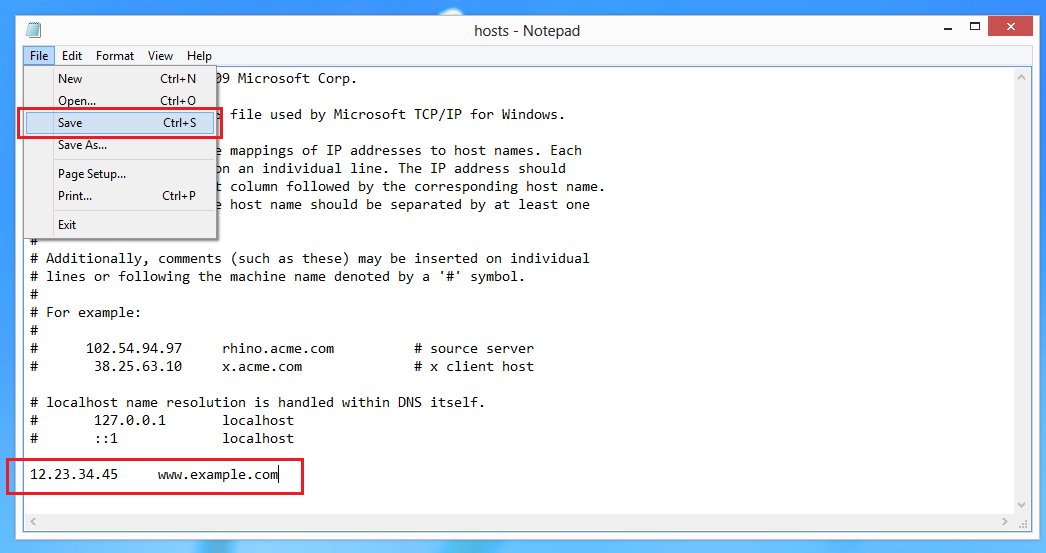

You can now edit your Hosts File and proceed with testing your new site like you normally would. Click OK to save your changes and close the window. Uncheck the box beside Enable DNS over HTTPS.Ħ. In the dialog box that opens, scroll down to Enable DNS over HTTPS.ĥ. In the General panel, scroll down to Network Settings and click the Settings button.Ĥ.

Click the menu button and select Options.ģ. Follow the directions below to disable this setting.Ģ. You can also manually navigate to the file. Type the following location in the text field for File Name and click Open. In the next window, navigate to Proceedings > Open.
#Windows hosts file windows
The second method is to disable DOH in your Firefox browser. Open Notepad by pressing Win + S typing notepad in windows search and clicking Execute as an administrator. Chrome, Edge, Safari, and many others do not have this setting enabled by default and will continue to work as expected with a modified hosts file. The IP address and the host name should be separated by. be placed in the first column followed by the corresponding host name. entry should be kept on an individual line. This file contains the mappings of IP addresses to host names. There are two primary ways to avoid this behavior while testing your new site. This is a sample HOSTS file used by Microsoft TCP/IP for Windows. This behavior guarantees that the website displayed points to the IP address that the Internet sees as authoritative for that domain. Firefox simply makes the DNS request over HTTPS from within the browser. Set the Save as type to All files and the File name to hosts.

Open notepad and copy the contents of the hosts file. You can create another host file and replace it with the original one to reset their permissions. That means instead of checking your local hosts file or even your DNS resolver. If there are problems with the hosts file’s permission settings, your browsers can’t access them.

You have now re-created the hosts file.Firefox now uses DNS over HTTPS (or DOH) by default. Step Copy the hosts file to C:\WINDOWS\system32\drivers\etc (Windows 7, XP, Vista) # localhost name resolution is handled within DNS itself.Ħ. # lines or following the machine name denoted by a ‘#’ symbol.
#Windows hosts file how to
Here's how to edit the Windows HOSTS file, which is necessary to make custom domain redirects, block websites, or remove malicious entries set by malware. Next, select Text Documents (txt) and change it to All Files > double-click hosts. # Additionally, comments (such as these) may be inserted on individual Open Notepad or another text editor > select File > Open > open Host file. # The IP address and the host name should be separated by at least one # be placed in the first column followed by the corresponding host name. # entry should be kept on an individual line. It is a plain text file, and the size of the original default Hosts file is around 824 bytes. # This file contains the mappings of IP addresses to host names. This Hosts file is located deep down in the Windows folder. # This is a sample HOSTS file used by Microsoft TCP/IP for Windows. # Copyright (c) 1993-2009 Microsoft Corp. Original content of the Windows hosts file: Step If you want to you can copy the default content of the hosts file into the text file, but it is not necessary because the default only includes comments (right-click on file, then Open with – Notepad). Step Rename the file to hosts and remove the file extension.
#Windows hosts file full
Full details here: Show file extensionsĤ. Step Make sure that you can actually see file extensions. Step Right-click on the white area and click on New – Text Documentģ. Step Open the MyDocuments folder or any other folder without system files.Ģ. If you can’t seem to find any you will have to create it.ġ. Windows XP/Vista/7: C:\WINDOWS\system32\drivers\etcįirst look into the folders above to see if you can find any backups or renamed files. Windows 2000: C:\WINNT\system32\drivers\etc Is your hosts file missing? Bummer… well, let’s re-create it.


 0 kommentar(er)
0 kommentar(er)
